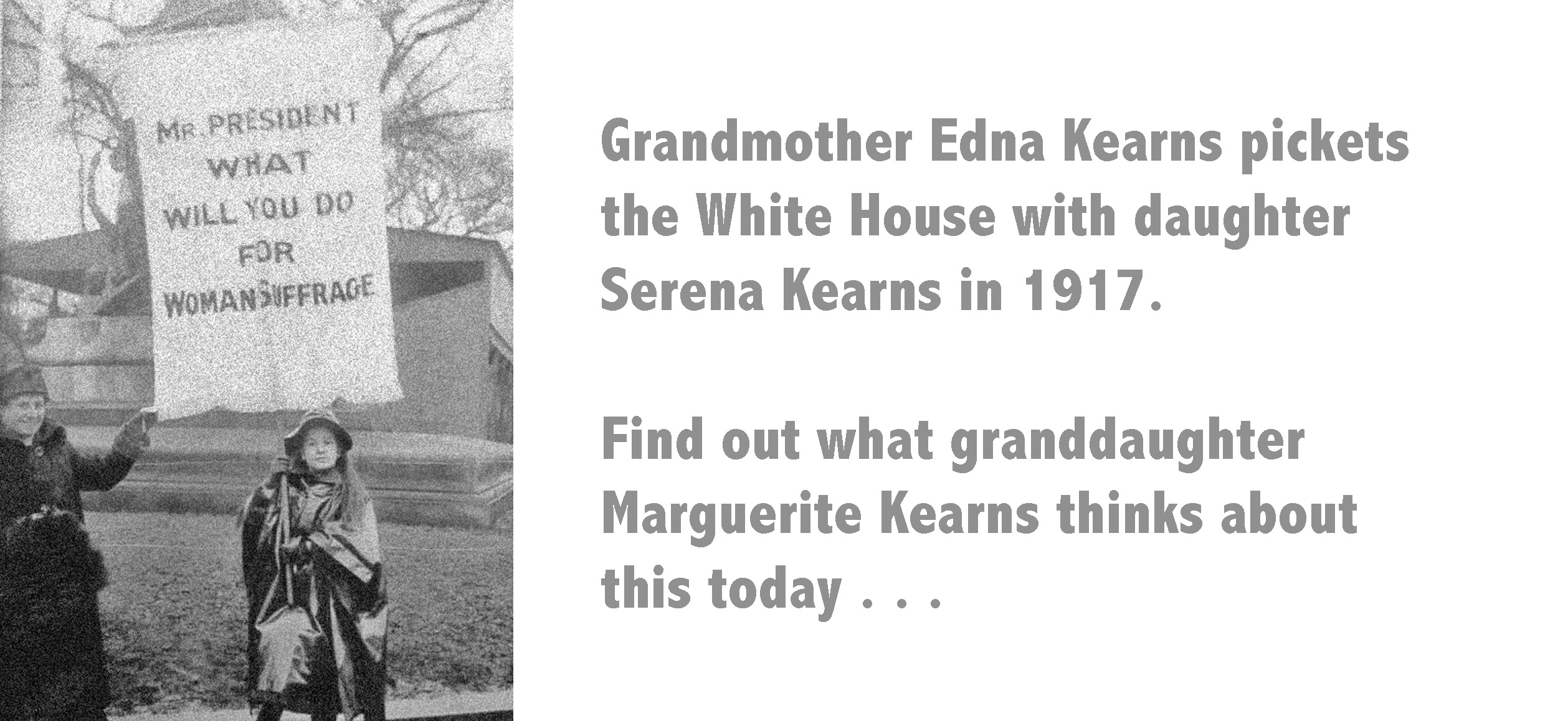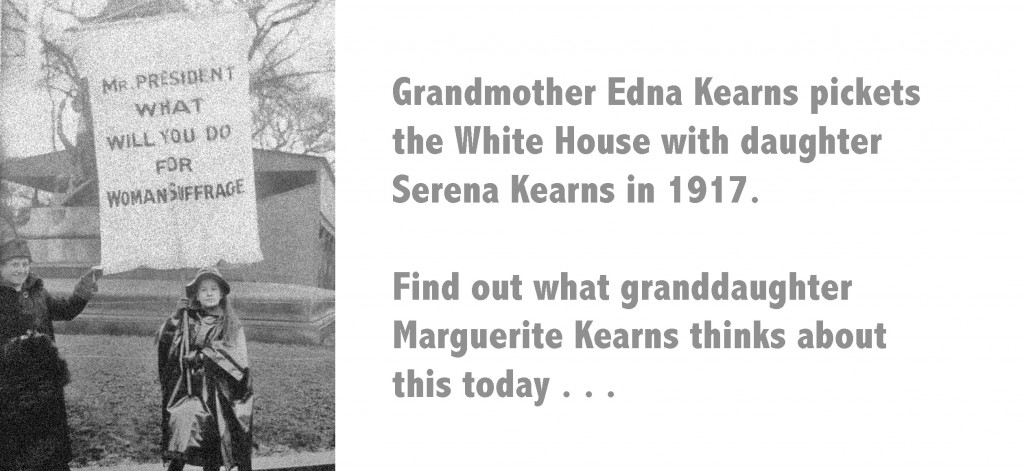Q: Why be concerned about the suffrage movement today? Isn’t it irrelevant now that women can vote in the United States?
Marguerite Kearns: My grandmother’s generation and generations before her pulled off a remarkable nonviolent social revolution. This was no small accomplishment. They were courageous. They were creative. They were politically astute. They suffered and sacrificed. They had a vision and would not deviate from it. They could laugh, enjoy themselves, and still inspire thousands of others. We can learn so much from their experience. Now is the time to recognize their remarkable contributions, live it in our own lives, and pass it on.
I’ve always been fascinated with my grandmother Edna Kearns’ suffrage campaign wagon, ever since I was young. Every summer my mother dressed us up in special outfits to sit in Edna’s wagon and have our photos taken. This was how I learned about the suffrage movement, along with family stories. The only time I heard anything in school about Votes for Women was when my eighth grade social studies teacher summed it up in one sentence: “And then in 1920, women were GIVEN the vote.”
I knew this wasn’t true. No one handed the vote to women on a silver platter. They struggled for it over a 72-year period. But I didn’t have my grandmother around to tell me the details. Edna Kearns died in 1934, long before I was born. So over the years, I’ve made a point of discovering Grandmother Edna through her writings, speeches, letters, and news articles.
I only wish I could have heard Grandmother Edna’s voice, listened to her stories. This job fell to my grandfather Wilmer Kearns who taught me what he knew. The suffrage movement changed my grandfather profoundly, and he was deeply concerned about social issues for the rest of his life.
Q: What about your grandmother’s suffrage wagon makes it significant today?
A: There’s nothing stuffy and old fashioned and irrelevant about the “Spirit of 1776.” The suffragists knew that the American Revolution was unfinished in 1913 when my grandmother Edna Kearns first took the wagon out on the road in New York City and Long Island for campaign purposes. The American Revolution remains unfinished for us today, and this is just as true for women around the world where their revolutions may be defined differently but the spirit to inspire and make change remains the same.
The suffrage activists used other horse-drawn wagons for campaign purposes across the United States, but after 1920 these vehicles were sold or used for utilitarian purposes. My grandmother knew enough to preserve the wagon, just as she saved her papers so that the story of how the vote was won could be told to future generations.
Edna’s suffrage wagon is in the collection of the New York State Museum, and it is believed to be the only campaign wagon available today for exhibition purposes. There’s one wagon which I believe is in the collection of the Smithsonian, and that’s a vehicle used for selling suffrage newspapers. A wagon is symbolic of taking an important message out into the world.
When people hear the real stories of the suffrage movement, they are fascinated and want to know more. A great deal has changed since the activists of the National Woman’s Party went to jail, and when my grandmother picketed the White House in their support in 1917. Being active politically and voting is as relevant and cutting edge as it has always been. A great deal has changed and a great deal remains the same. As long as injustices and glass ceilings and inequalities exist, we can access the same “Spirit of 1776” that the women of the suffrage movement used as their inspiration.
Q: Why do you write and publish Suffrage Wagon News Channel?
A: Suffrage Wagon News Channel (suffragewagon.org) (womenssuffrage.org) is a way to learn about my grandmother Edna and honor her and all the other women of her generation. They were brave and persistent and committed. We need these qualities. We instinctually know what to do because our grandmothers and great grandmothers forged a path of change. The news and story channel is a way to receive a torch from the past, hold it high, and pass it to the next generation. Knowing about the suffrage movement is a way to rediscover what we already have within us, and this is an instinct and passion for freedom and equality and the courage to persist until our dreams are realized.
Q: Why is suffrage activist Edna Kearns important?
A: Grandmother Edna wasn’t famous, though she was well known in suffrage circles as a hard worker and for her dedication. I tell people that she represents the tens of thousands of women across the nation whose names we will never know and the documentation of their activism has been lost to us forever. Edna’s stories came down to me because of her suffrage wagon and because she was a squirrel who saved everything. Like many suffragists, Grandmother Edna was aware of the importance of documentation and the necessity of creating your own media to get out the word.
My grandmother’s generation had to learn skills they found necessary for winning Votes for Women. There were no trainings in grassroots organizing, no digital tools to create databases, no studies in civil disobedience and nonviolence. My grandmother had a high school education in a Quaker school in Philadelphia. She hit the ground running in New York State where she lived from 1904 to 1920. She used her innate curiosity to find out how the world worked and how to get things done in the suffrage movement.
Edna Buckman Kearns became an editor and a writer of suffrage news. She served as a leader in many local suffrage organizations, and as press chair on Long Island in New York State for local, state and national campaigns. She was an activist for the National Woman’s Party. She rolled up her sleeves and learned on the job. Edna devoted a decade of her life, full time, to the cause.
I share my grandmother with others. If my grandmother was so committed, so were other grandmothers and great grandmothers and family members. Even the men of my family were involved. My grandfather Wilmer Kearns marched in the men’s divisions of suffrage parades. When Edna attended suffrage conferences and was involved in special events and activities, he took care of their older daughter Serena Kearns and answered the phone and correspondence. The suffrage movement, for many, was a family affair.
My mother Wilma Buckman Kearns was born on November 12, 1920. When women across the nation were getting ready to vote en masse, my grandmother Edna was having labor pains. She’d already been voting since 1917 when New York women won the vote. I never thought to ask my mother whether or not Grandmother Edna voted in 1920. It’s something I will never know.
Q: What about the world today and our responsibility for the future?
A: We’ve come a long way. As we celebrate our accomplishments, we can reach out to women around the world whose lives are more like the norm during my grandmother’s generation. There’s a great deal to do. When people ask me how to make change, I say: “Dig where you stand.” Start where you can. For some, this means on the personal level. Make changes in yourself. Make change in your family, community, state, region, nation, and on Planet Earth.
There are so many issues and situations to choose from. Learn as you go. Keep chipping away. Make friends. Join coalitions. Use suffrage campaign wagons that are comparable for our times. New technological tools give us an opportunity to potentially reach millions of people and bring about a world that’s safe and sane and meaningful for all living beings.
Remember our grandmothers, great grandmothers, and ancestors. They blazed a trail. The least we can do is to make the path wider. Receive the torch, hold it high, and pass it on. The suffrage activists used the torch as a symbol, and many photos have come down to us using this image. They also stressed living in and carrying on the “Spirit of 1776.” This is the time to live in that spirit and joyfully carry it on.

